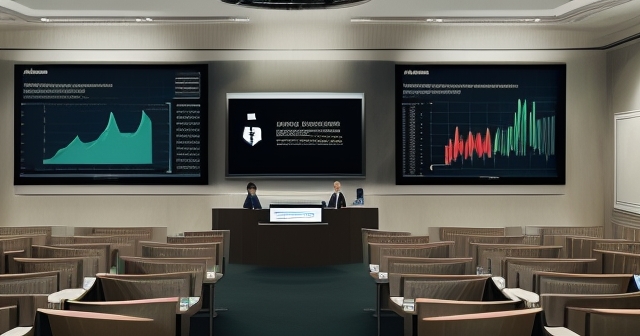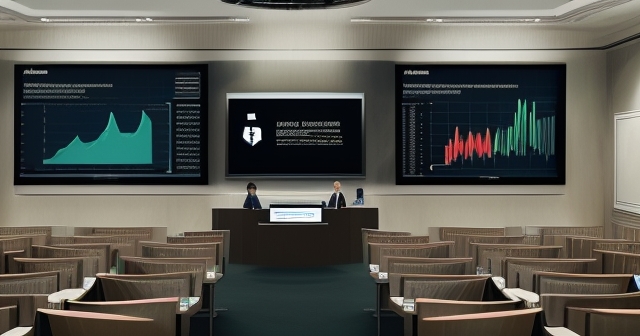“`html
Understanding AML in Banking: Safeguarding the Financial System You Navigate
Welcome to a deep dive into a critical, yet often complex, aspect of the financial world: Anti-Money Laundering (AML) and Countering the Financing of Terrorism (CFT). As individuals engaging with banks, investment firms, and trading platforms, understanding how these institutions protect the system is paramount. Think of it like understanding the security measures of a building before you entrust your valuables to a safe deposit box inside. For financial institutions, this security system is their AML/CFT program.

Whether you are just starting your investment journey or are an experienced trader exploring intricate strategies, knowing the foundational principles of AML compliance will provide you with valuable insights into the operational integrity and trustworthiness of the financial entities you interact with. We’ll explore the regulations, the processes, and the vital role these play in maintaining a stable and secure financial environment.
- Understanding the role of AML/CFT in financial stability.
- The impact of money laundering and terrorist financing on the economy.
- Importance of compliance for financial institutions and their clients.
What Exactly Are Money Laundering and Terrorist Financing? Why Do We Need AML/CFT?
Before we delve into the regulations, let’s clarify the core issues AML and CFT seek to combat. These aren’t abstract concepts; they represent significant threats to economic stability and national security.
Money Laundering (ML): This is the process of making illegally-gained proceeds (“dirty money”) appear legal (“clean money”). Criminals aim to disguise the origin of their illicit funds so they can be used without detection. It typically involves three stages:
- Placement: Introducing the illegal funds into the financial system (e.g., depositing cash into bank accounts).
- Layering: Conducting complex financial transactions to obscure the trail of the money, making it hard to trace its source (e.g., transferring funds between accounts, using shell companies).
- Integration: Returning the “cleaned” money to the criminal from apparently legitimate sources (e.g., investing in real estate, businesses).
Terrorist Financing (TF): Unlike money laundering, the source of funds for terrorist financing may be legitimate (e.g., donations), but the purpose is illicit – funding terrorist acts or organizations. CFT aims to prevent funds, regardless of their origin, from being used for terrorist activities.
These illicit activities undermine financial markets, distort economic decision-making, and fuel serious crimes like drug trafficking, corruption, and securities fraud (often referred to as “predicate offenses” that generate the dirty money). As a financial institution, or someone trusting one, you want to be absolutely certain that the system isn’t being used to facilitate these harms. AML/CFT measures are our collective defense.

The Regulatory Backbone: The Bank Secrecy Act (BSA) and Its Implementing Rules
In the United States, the foundation of AML/CFT regulation for financial institutions is the Bank Secrecy Act (BSA), enacted in 1970. Think of the BSA as the primary rulebook. Its core purpose is to require financial institutions to establish programs, maintain records, and file reports that are highly useful in criminal, tax, and regulatory investigations and proceedings.
The BSA doesn’t just apply to traditional banks. Its reach extends to a wide array of financial service providers, including broker-dealers, money services businesses, casinos, and more. These institutions are required to maintain records of certain types of transactions and file reports with the government, primarily with the Financial Crimes Enforcement Network (FinCEN), which is the U.S. Financial Intelligence Unit (FIU).

Implementing regulations, often found in the Code of Federal Regulations (CFR) under Title 31, Chapter X (31 C.F.R. chapter X), provide detailed requirements for different types of financial institutions. These rules specify what a compliant AML program must contain, the types of records to keep, and the triggers for reporting suspicious activity.
So, when you open an account or conduct a significant transaction, the institution isn’t just being nosy; they are fulfilling specific legal obligations under the BSA and its implementing regulations to help detect and prevent illicit finance.
The Game Changer: The AML Act of 2020
While the BSA provided the foundation, the financial crime landscape is constantly evolving, particularmente with the rise of new technologies and global interconnectedness. Recognizing this, Congress passed the Anti-Money Laundering Act of 2020 (AML Act 2020) as part of the National Defense Authorization Act.
This legislation is a significant modernization of the BSA. It didn’t replace the BSA but substantially amended it, strengthening and expanding existing requirements. One of the most explicit changes was formally and prominently integrating Countering the Financing of Terrorism (CFT) into the statute’s explicit purpose and requirements, emphasizing that AML efforts are intrinsically linked to national security.
A key mandate of the AML Act 2020 is the requirement for FinCEN, in coordination with other relevant agencies, to establish national AML/CFT priorities. These priorities are meant to guide financial institutions in tailoring their risk-based programs to address the most significant threats identified by the government. This means compliance isn’t just about following a checklist; it’s about actively assessing your institution’s risk exposure based on these national priorities and designing your controls accordingly.
The AML Act 2020 also brought other notable changes, such as enhancing information sharing between government agencies and financial institutions, encouraging technological innovation in AML compliance, and increasing penalties for serious BSA violations. It signaled a clear intent to make the U.S. AML regime more effective and risk-focused.
Who’s Watching? Key Regulatory Bodies and Their Roles
Compliance with AML/CFT regulations isn’t overseen by just one entity. A network of federal agencies shares responsibility for supervising different sectors of the financial industry.
| Agency | Role |
|---|---|
| FinCEN (Financial Crimes Enforcement Network) | Administrator of the BSA, responsible for collecting and analyzing reports. |
| FINRA (Financial Industry Regulatory Authority) | Supervises broker-dealers and enforces AML rules in the securities industry. |
| Banking Agencies | Regulate banks and credit unions for BSA/AML compliance. |
This multi-agency approach ensures broad coverage but also requires coordination to provide clear and consistent guidance to financial institutions. When you interact with a regulated financial entity, know that there are specific supervisors holding them accountable for their AML program’s effectiveness.
The Building Blocks of Compliance: KYC, CDD, and CIP
At the heart of any effective AML program are processes designed to know who the customers are and understand the risks they pose. These are commonly referred to as Know Your Customer (KYC), Customer Due Diligence (CDD), and Customer Identification Program (CIP).
Customer Identification Program (CIP): This is usually the first step when you open an account. The CIP is a mandatory component of an AML program (specifically required by regulations implementing Section 326 of the USA PATRIOT Act, an amendment to the BSA). A CIP must include procedures for:
- Collecting Identifying Information: Gathering information from customers, such as name, date of birth, address, and identification number (like a Social Security Number or taxpayer identification number).
- Verifying Customer Identity: Using the information collected to form a reasonable belief that you know the true identity of the customer. This can be done through documentary methods (e.g., examining a driver’s license or passport) or non-documentary methods (e.g., verifying information through public databases).
- Maintaining Records: Keeping records of the information collected and the verification process.
- Determining if the Customer Appears on Terrorist Lists: Checking government lists, such as the Specially Designated Nationals (SDN) list maintained by the Office of Foreign Assets Control (OFAC).
So, when you’re asked for your ID and other details to open an account, you’re participating in the institution’s CIP process.
Customer Due Diligence (CDD): CDD goes beyond simply identifying the customer. It involves understanding the nature and purpose of the customer relationship to develop a risk profile and conduct ongoing monitoring. Regulations require financial institutions to implement risk-based procedures for CDD, which include:
- Understanding Customer Relationships: Gaining insight into the types of transactions the customer expects to conduct and the volume of activity.
- Developing Customer Risk Profiles: Assessing the potential risk for money laundering or terrorist financing posed by the customer based on factors like their business type, geographic location, expected activity, and beneficial owners.
- Ongoing Monitoring: Conducting ongoing monitoring of customer activity to identify and report suspicious transactions and, on a risk basis, maintaining and updating customer information, including beneficial ownership information.
| Key Component | Description |
|---|---|
| Customer Identification | Gathering basic identifying information from customers. |
| Risk Profiling | Assessing potential risks linked to the customer. |
| Ongoing Monitoring | Continually assessing customer transactions for unusual patterns. |
Beneficial Ownership: A crucial part of CDD involves identifying the individuals who ultimately own or control a legal entity customer (like a corporation or LLC). This helps prevent criminals from hiding behind complex corporate structures. FinCEN has specific rules requiring covered financial institutions to identify and verify the identity of the beneficial owners of legal entity customers.
CDD is an ongoing process. Your risk profile isn’t static; it can change over time, and the institution’s monitoring is designed to catch shifts that might indicate suspicious activity. These processes are fundamental to building a clear picture of who is using the financial system.
The Engine Room: Internal Controls, Training, and Testing
A compliant AML program isn’t just about having policies; it requires operational components working together effectively. Think of these as the engine, steering wheel, and maintenance schedule of the AML security system.
Internal Controls: These are the policies, procedures, and processes designed to ensure day-to-day compliance with AML rules and to manage and mitigate risks identified by the institution. Effective internal controls are risk-based and should cover areas such as:
- Procedures for conducting CIP and CDD.
- Processes for identifying and reporting suspicious activity.
- Guidelines for handling high-risk customers or transactions.
- Segregation of duties to prevent a single individual from controlling an entire process.
AML Compliance Officer: BSA regulations require financial institutions to designate a qualified individual responsible for managing the AML program. This person is tasked with ensuring the program is implemented effectively, staying updated on regulatory changes, and serving as the point person for regulatory examinations and law enforcement inquiries.
Training: Ongoing training is mandatory for appropriate personnel. This isn’t a one-time event. Staff who interact with customers, handle transactions, or are involved in compliance oversight need to be trained on AML risks, the institution’s policies and procedures, how to identify red flags, and their reporting obligations. Training should be tailored to the employee’s specific role and the risks they might encounter.
Independent Testing: Regular independent testing (or auditing) of the AML program is crucial. This testing must be conducted by internal staff independent of the AML program’s operations or by a qualified external party. The purpose is to objectively assess the program’s effectiveness, identify weaknesses, and recommend corrective actions. The scope and frequency of testing should be commensurate with the institution’s risk profile.

These elements – controls, a dedicated officer, training, and testing – work in synergy to create a robust and dynamic AML program that can adapt to changing threats and regulatory expectations.
Reporting Suspicion: SARs and Other Obligations
Even with the best preventive measures, financial institutions may encounter activity that appears suspicious. This is where reporting obligations become critical, acting as vital intelligence conduits for law enforcement and national security.
The most important reporting mechanism is the Suspicious Activity Report (SAR). Financial institutions are required to file a SAR with FinCEN if they know, suspect, or have reason to suspect that a transaction or a series of transactions involves funds derived from illegal activity, is designed to evade BSA requirements, lacks a legitimate business purpose, or involves the use of the institution to facilitate criminal activity.
SARs are filed electronically through FinCEN’s BSA E-Filing System. They must contain detailed information about the suspicious activity, the individuals involved, and supporting documentation. The information contained in SARs is highly confidential and is protected by strict non-disclosure rules; institutions and their employees are prohibited from notifying the person involved in the transaction that a SAR has been filed. Why this secrecy? To prevent tipping off criminals and compromising investigations.
| Reporting Requirement | Description |
|---|---|
| Currency Transaction Reports (CTRs) | Filed for transactions involving more than $10,000 in currency. |
| Reports of Foreign Bank Accounts (FBARs) | Filed by U.S. persons with foreign financial accounts exceeding a certain threshold. |
| Reports of International Transportation of Currency (CMIRs) | Filed when transporting more than $10,000 out of the U.S. |
The filing of SARs, in particular, is a cornerstone of the AML regime, providing critical leads that enable authorities to trace illicit funds and prosecute financial criminals. The scale of this effort is significant, with FinCEN receiving over 3.6 million SARs and 15 million CTRs in Fiscal Year 2022 alone.
A Risk-Based Approach: Tailoring Your Program
A key theme running through modern AML regulations and guidance, particularly reinforced by the AML Act 2020, is the emphasis on a risk-based approach. This means that financial institutions shouldn’t treat all customers and transactions identically. Instead, they must allocate their compliance resources and implement controls in a manner commensurate with the money laundering and terrorist financing risks they reasonably expect to encounter.
How does an institution determine its risk profile? This involves a systematic risk assessment process considering factors such as:
- Customer Types: Certain customer types may inherently pose higher risks.
- Products and Services: Some products or services might be more vulnerable to misuse for illicit finance.
- Geographic Locations: Jurisdictions known for higher levels of corruption can elevate risk.
- Delivery Channels: How customers access services can impact risk.
Based on this assessment, the institution tailors its CDD procedures (e.g., requiring more verification for high-risk customers), monitoring intensity, and internal controls. A lower-risk customer might require standard CDD, while a higher-risk customer would require Enhanced Due Diligence (EDD), involving more extensive information gathering and scrutiny. This targeted approach makes compliance efforts more efficient and effective at addressing the most significant threats.
The AML Act 2020’s directive for financial institutions to align their programs with FinCEN’s national priorities further solidifies this risk-based philosophy, directing institutions to focus their resources on areas the government has identified as posing the greatest threat to the U.S. financial system.
For you as an investor or trader, understanding the institution’s risk-based approach helps explain why different customers might experience slightly different onboarding or monitoring processes. It’s a reflection of the system working to identify and manage potential threats proportionally.
Staying Ahead: Recent Developments and Future Rules
The AML landscape is not static; it’s constantly evolving to counter new threats and incorporate lessons learned. Regulators frequently issue new guidance or propose changes to existing rules.
A notable recent development stems directly from the AML Act 2020. In the summer of 2024, FinCEN and the federal banking agencies (FDIC, Federal Reserve, OCC, NCUA) each issued Notices of Proposed Rulemaking (NPRMs). These proposed rules aim to formally incorporate key provisions of the AML Act 2020 into their respective regulations.
While still proposals, these NPRMs signal important future changes. They aim to explicitly require financial institutions’ AML programs to be “reasonably designed” to assure compliance with the BSA and its implementing regulations AND to assist in the government’s efforts to combat ML and TF, including by incorporating FinCEN’s national AML/CFT priorities into the institution’s risk assessment and program design processes. They also seek to refine the requirements for CDD and ongoing monitoring, emphasizing the risk-based nature of these processes.
Staying informed about these proposed rules and final regulations is critical for financial institutions. For market participants, it provides insight into how the compliance efforts safeguarding the financial system are being strengthened. It shows that regulators and institutions are actively working to close potential loopholes and enhance the effectiveness of AML/CFT controls.
These ongoing developments underscore the dynamic nature of financial crime and the continuous effort required to stay one step ahead. Compliance isn’t just a requirement; it’s an ongoing commitment to learning and adapting.
The Global Picture: International Standards and Cooperation
Money laundering and terrorist financing are inherently transnational crimes. Funds can move across borders quickly, exploiting differences in national regulations. Therefore, effective AML/CFT efforts require international cooperation and common standards.
Global standard-setting bodies, most notably the Financial Action Task Force (FATF), play a critical role. The FATF issues Recommendations that are recognized as the international standard for combating ML, TF, and proliferation financing (PF). Countries are assessed by the FATF and regional bodies on their implementation of these standards.
Organizations like the International Monetary Fund (IMF) also contribute significantly to the global AML/CFT architecture. The IMF conducts assessments of member countries’ AML/CFT frameworks as part of its financial sector surveillance and provides capacity development assistance to help countries build stronger AML/CFT regimes. Their work highlights the link between financial integrity and global financial stability.
International cooperation is also essential for investigation and enforcement. Mechanisms like Mutual Legal Assistance Treaties (MLATs) allow countries to share information and evidence in criminal investigations. Information sharing between Financial Intelligence Units (FIUs) across borders is also vital, often facilitated through bodies like the Egmont Group.
While this article has focused primarily on the U.S. regulatory framework, it’s important to remember that these efforts are part of a larger global fight. The stability and integrity of the financial institutions you use are bolstered not just by national laws but also by this complex web of international standards, cooperation, and capacity building.
Why Does This Matter to You, the Investor or Trader?
You might be thinking, “Okay, this is important for banks, but why do I need to know the details?” Understanding the AML/CFT framework provides several benefits for you:
- Trust and Confidence: Knowing that financial institutions are subject to stringent AML rules and oversight can build your confidence in the integrity of the markets and platforms you use. It assures you that efforts are being made to keep illicit funds out.
- Navigating Onboarding: Understanding KYC/CIP/CDD explains why institutions ask for certain information and documents. You can appreciate that these are regulatory requirements designed for security, not arbitrary hurdles.
- Recognizing Legitimate Platforms: Familiarity with compliance concepts allows you to better evaluate the legitimacy and regulatory adherence of financial service providers. A firm with robust, well-explained AML procedures is generally more trustworthy.
- System Stability: By helping prevent financial crime, AML/CFT contributes to the overall stability of the financial system. A system flooded with illicit funds is vulnerable to crises, which can negatively impact investments and trading activities.
Consider the analogy again: knowing about the building’s security system reassures you your safe deposit box is safe. Similarly, understanding the AML framework reassures you that the financial system and the institutions within it are working to protect against financial crime.
Understanding these rules is vital whether you bank traditionally or engage in online trading activities. If you’re exploring online trading platforms or various CFD instruments, knowing they adhere to robust AML/CFT measures is key to your security and the integrity of your trading environment. For instance, if you’re looking for a platform with strong regulatory backing for trading forex or CFDs, consider researching brokers that comply with stringent requirements like those enforced by ASIC, FSCA, or FSA, which often mirror or exceed BSA principles regarding customer identification and ongoing monitoring.
Conclusion: An Ongoing Commitment to Integrity
Anti-Money Laundering and Countering the Financing of Terrorism are not static checklists but dynamic processes essential to the health and security of the global financial system. From the foundational requirements of the BSA and the modernization brought by the AML Act 2020, to the crucial operational elements of KYC, CDD, CIP, internal controls, training, and independent testing, financial institutions are constantly working to detect and prevent illicit financial flows.
The reporting obligations, particularly the filing of SARs, provide invaluable intelligence to authorities, enabling the investigation and prosecution of financial criminals. The shift towards a risk-based approach allows institutions to focus their resources where they are most needed, aligning their efforts with national priorities and evolving threats.
As you navigate the financial world, whether as an investor or trader, understanding these principles provides clarity on the processes you encounter and reinforces the importance of choosing institutions committed to regulatory compliance and financial integrity. It’s a complex world, but one where robust AML/CFT measures are constantly working behind the scenes to safeguard the system for all legitimate participants.
Staying informed about regulatory developments, like the recent NPRMs, ensures you have a complete picture of the continuous efforts to strengthen these vital protections. The fight against illicit finance is a shared responsibility, and informed participation in the financial system begins with understanding the rules that keep it secure.
aml acronym bankingFAQ
Q:What does AML stand for in banking?
A:AML stands for Anti-Money Laundering, referring to the laws and regulations designed to prevent and combat money laundering activities.
Q:Why is AML important for investors?
A:AML is important because it safeguards the financial system from illicit activities, ensuring a trustworthy environment for investments.
Q:What are the main components of an AML program?
A:Main components include customer identification and due diligence (CIP/CDD), internal controls, employee training, and reporting suspicious activities.
“`
